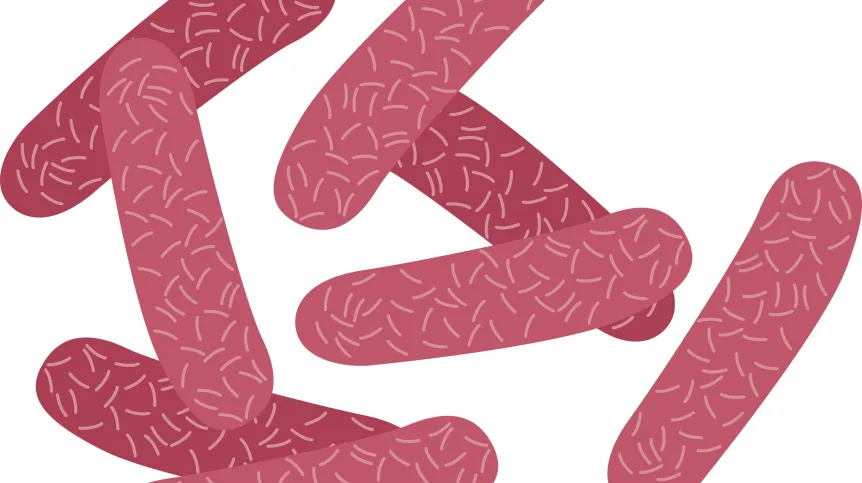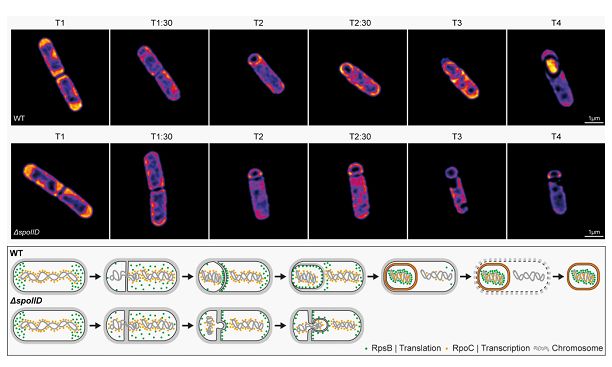
Polish scientists have discovered and described how the position of ribosomes, or the protein-producing machinery, changes during the formation of a spore in Bacillus subtilis. The researchers have also shown what necessary changes must occur in the structure of the cell in order for a mature spore to form.
When a population of bacteria senses a lack of nutrients, most bacterial cells produce spores - forms that are resistant to extreme environmental conditions. When favourable conditions return, the spore 'wakes up' to life. Once the bacterium produces a spore, it is very difficult to get rid of it, which is a problem in disinfection and fighting bacterial infections.
Scientists from the Laboratory of Traslatomics at the Institute of Biochemistry and Biophysics PAS in collaboration with scientists from the University of Wrocław examined what exactly happened when a bacterial cell produced spores. They took on the issue of sporulation in the bacteria Bacillus subtilis. They reported on their research in a release sent to PAP.
'Bacteria do not have cell organelles such as mitochondria or cell nuclei. For a long time, it seemed that bacterial cells were a disordered system of macromolecules limited by a membrane and a cell wall. Meanwhile, our research clearly shows that the internal life of bacteria is meticulously organized and divided into functionally diverse zones', says the team leader, Agata Starosta, PhD, from the Institute of Biochemistry and Biophysics PAS.
The research, published in “Nature Communications” shows that in B. subtilis cells, the translation process (translation of the genetic code into proteins) during spore formation and the translation machinery are temporally and spatially organized. The asymmetric partition can be considered the control centre for cell development. And the emerging endospore 'inherits' ribosomes from the mother cell.

The scientists used modern imaging techniques such as SIM (Structured Light Microscopy) and fluorescence microscopy with experiments based on 'click' chemistry for imaging protein synthesis in action to observe dynamic changes in the location of ribosomes during sporulation.
'Until now, we knew that for a a spore to form in B. subtilis, asymmetric cell division, the formation of a so-called asymmetric partition, and the transport of the bacterial chromosome to a newly created compartment in the mother cell, the prespore, were necessary. Thanks to our research, we have observed that the location of ribosomes is also subject to strict spatial and temporal control, and the main organizational factor here is the asymmetric partition, which serves as the control centre for spore development, including translation regulation', Starosta explains.
However, in order for the prespore to transform into a mature spore, the mother cell must supply it with translation machinery. This is possible thanks to the reconstruction of the asymmetric partition, which is made of the same components as the cell wall and membrane.
'After the chromosome is transported to the prespore, the structure of the asymmetric partition is significantly rearranged', explains Olga Iwańska, PhD, co-author of the paper. Due to this process, ribosomes previously located in the mother cell are able to enter the newly formed spore. The researcher adds that in mutants deprived of genes encoding the so-called DMP complex proteins, the asymmetric partitions were impermeable to ribosomes. Ribosomes could not pass from the mother cell to the prespore, and consequently, these mutants could not produce mature spores.
The scientists have demonstrated another level of intracellular organization in bacteria and proposed that ribosome movement within the cell may be mediated by bacterial homologues of cytoskeletal proteins, and that clues to the precise location of the asymmetric partition may be translation-dependent. Furthermore, this discovery could play a key role in the search for new antibiotic targets in sporulating bacteria.
The paper was prepared with the support of the Foundation for Polish Science (FIRST TEAM grant) and EMBO (Installation Grant).
PAP - Science in Poland
lt/ agt/













